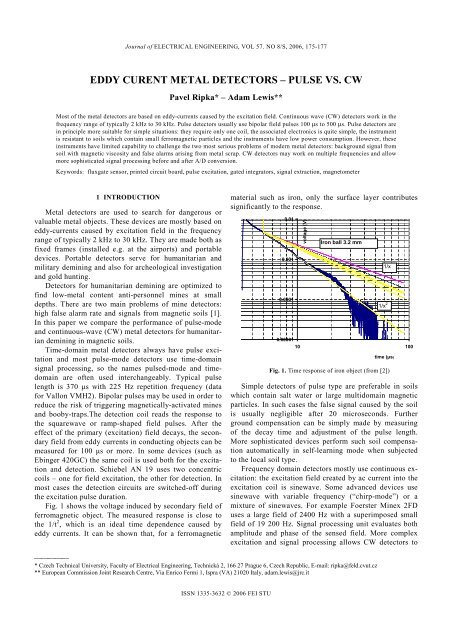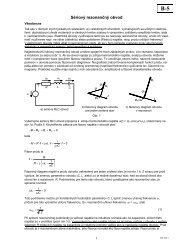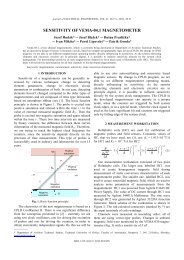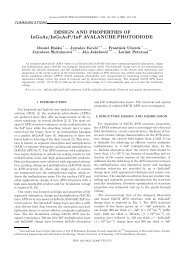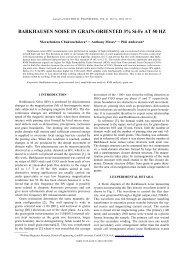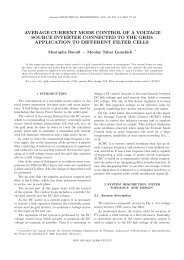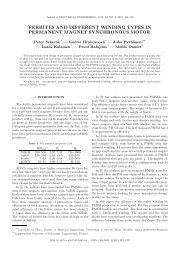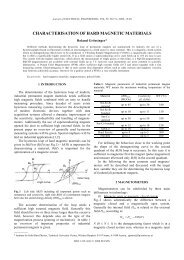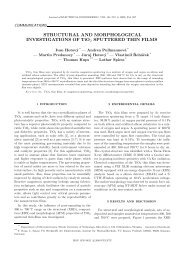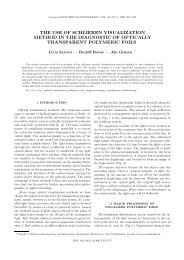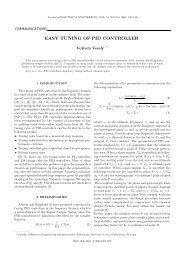EDDY CURENT METAL DETECTORS – PULSE VS. CW
EDDY CURENT METAL DETECTORS – PULSE VS. CW
EDDY CURENT METAL DETECTORS – PULSE VS. CW
You also want an ePaper? Increase the reach of your titles
YUMPU automatically turns print PDFs into web optimized ePapers that Google loves.
Journal of ELECTRICAL ENGINEERING, VOL 57. NO 8/S, 2006, 175-177<br />
<strong>EDDY</strong> <strong>CURENT</strong> <strong>METAL</strong> <strong>DETECTORS</strong> <strong>–</strong> <strong>PULSE</strong> <strong>VS</strong>. <strong>CW</strong><br />
Pavel Ripka* <strong>–</strong> Adam Lewis**<br />
Most of the metal detectors are based on eddy-currents caused by the excitation field. Continuous wave (<strong>CW</strong>) detectors work in the<br />
frequency range of typically 2 kHz to 30 kHz. Pulse detectors usually use bipolar field pulses 100 μs to 500 μs. Pulse detectors are<br />
in principle more suitable for simple situations: they require only one coil, the associated electronics is quite simple, the instrument<br />
is resistant to soils which contain small ferromagnetic particles and the instruments have low power consumption. However, these<br />
instruments have limited capability to challenge the two most serious problems of modern metal detectors: background signal from<br />
soil with magnetic viscosity and false alarms arising from metal scrap. <strong>CW</strong> detectors may work on multiple frequencies and allow<br />
more sophisticated signal processing before and after A/D conversion.<br />
Keywords: fluxgate sensor, printed circuit board, pulse excitation, gated integrators, signal extraction, magnetometer<br />
1 INTRODUCTION<br />
Metal detectors are used to search for dangerous or<br />
valuable metal objects. These devices are mostly based on<br />
eddy-currents caused by excitation field in the frequency<br />
range of typically 2 kHz to 30 kHz. They are made both as<br />
fixed frames (installed e.g. at the airports) and portable<br />
devices. Portable detectors serve for humanitarian and<br />
military demining and also for archeological investigation<br />
and gold hunting.<br />
Detectors for humanitarian demining are optimized to<br />
find low-metal content anti-personnel mines at small<br />
depths. There are two main problems of mine detectors:<br />
high false alarm rate and signals from magnetic soils [1].<br />
In this paper we compare the performance of pulse-mode<br />
and continuous-wave (<strong>CW</strong>) metal detectors for humanitarian<br />
demining in magnetic soils.<br />
Time-domain metal detectors always have pulse excitation<br />
and most pulse-mode detectors use time-domain<br />
signal processing, so the names pulsed-mode and timedomain<br />
are often used interchangeably. Typical pulse<br />
length is 370 µs with 225 Hz repetition frequency (data<br />
for Vallon VMH2). Bipolar pulses may be used in order to<br />
reduce the risk of triggering magnetically-activated mines<br />
and booby-traps.The detection coil reads the response to<br />
the squarewave or ramp-shaped field pulses. After the<br />
effect of the primary (excitation) field decays, the secondary<br />
field from eddy currents in conducting objects can be<br />
measured for 100 µs or more. In some devices (such as<br />
Ebinger 420GC) the same coil is used both for the excitation<br />
and detection. Schiebel AN 19 uses two concentric<br />
coils <strong>–</strong> one for field excitation, the other for detection. In<br />
most cases the detection circuits are switched-off during<br />
the excitation pulse duration.<br />
Fig. 1 shows the voltage induced by secondary field of<br />
ferromagnetic object. The measured response is close to<br />
the 1/t 2 , which is an ideal time dependence caused by<br />
eddy currents. It can be shown that, for a ferromagnetic<br />
⎯⎯⎯⎯⎯<br />
* Czech Technical University, Faculty of Electrical Engineering, Technická 2, 166 27 Prague 6, Czech Republic, E-mail: ripka@feld.cvut.cz<br />
** European Commission Joint Research Centre, Via Enrico Fermi 1, Ispra (VA) 21020 Italy, adam.lewis@jrc.it<br />
ISSN 1335-3632 © 2006 FEI STU<br />
material such as iron, only the surface layer contributes<br />
significantly to the response.<br />
0.01<br />
0.001<br />
0.0001<br />
0.00001<br />
voltage (V)<br />
Iron ball 3.2 mm<br />
1/x<br />
1/x 2<br />
10 100<br />
time (µs)<br />
Fig. 1. Time response of iron object (from [2])<br />
Simple detectors of pulse type are preferable in soils<br />
which contain salt water or large multidomain magnetic<br />
particles. In such cases the false signal caused by the soil<br />
is usually negligible after 20 microseconds. Further<br />
ground compensation can be simply made by measuring<br />
of the decay time and adjustment of the pulse length.<br />
More sophisticated devices perform such soil compensation<br />
automatically in self-learning mode when subjected<br />
to the local soil type.<br />
Frequency domain detectors mostly use continuous excitation:<br />
the excitation field created by ac current into the<br />
excitation coil is sinewave. Some advanced devices use<br />
sinewave with variable frequency (“chirp-mode”) or a<br />
mixture of sinewaves. For example Foerster Minex 2FD<br />
uses a large field of 2400 Hz with a superimposed small<br />
field of 19 200 Hz. Signal processing unit evaluates both<br />
amplitude and phase of the sensed field. More complex<br />
excitation and signal processing allows <strong>CW</strong> detectors to
176 P. Ripka et al: <strong>EDDY</strong> <strong>CURENT</strong> <strong>METAL</strong> <strong>DETECTORS</strong> <strong>–</strong> <strong>PULSE</strong> <strong>VS</strong>. <strong>CW</strong><br />
compensate for the soil effect also. It should also be mentioned<br />
that signal processing in the frequency domain can<br />
be used also for pulse detectors.<br />
Some devices use differential receiving coil (e.g. double-D<br />
coil) which allows measurement in the vicinity of<br />
metal objects, e.g. rails. A similar effect is achieved by<br />
using Dynamic mode, in which any stable signal is suppressed<br />
by filters. These devices can detect a metal object<br />
only when the detector is moving. This mode is used e.g.<br />
by Vallon.<br />
2 DIFFICULT SOILS<br />
Some soils contain superparamagnetic nanoparticles,<br />
which exhibit magnetic viscosity, i.e. frequency dependence<br />
of susceptibility or non-instant response to the field<br />
step [3]. The ideal time response according to Neel theory<br />
and supposing uniform volume distribution of these particles<br />
is 1/t. During our soil time-domain measurements we<br />
found responses from 1/t 1.1 to 1/t 1.3 . An example of a<br />
measured response of this type of soil is in Fig. 2.<br />
0,01<br />
0,001<br />
0,0001<br />
0,00001<br />
1 10 time (µs) 100<br />
V o lta g e (V )<br />
DEP3A<br />
1/t 1.1<br />
Fig. 2. Time response of soil containing magnetic nanoparticles<br />
We have also measured frequency response of soil<br />
samples using insertion method. An example of the measured<br />
frequency response is in Fig. 3. The frequency<br />
characteristics is linear in loglin scale, which corresponds<br />
to even volume distribution of superparamagnetic<br />
particles. The target of our study is to show that in some<br />
cases measurements on soil samples can replace field testing<br />
of metal detectors when fast decision should be made<br />
which type of available detector would fit the best the<br />
local environmental conditions. Multifrequency metal<br />
detectors allow to compensate for the influence of all soils<br />
and they can be also used for automatic identification of<br />
objects: initial results were demonstrated in [4].<br />
For deep objects, large-loop detectors such as Geonix<br />
EM 61 are used. Some of these devices (such as Ebinger<br />
UPEX 748 M) also use pulse-mode excitation. These devices<br />
can detect deeply burried large objects with detection<br />
range up to 3 m for 1 m large coil.<br />
1/t<br />
3 OTHER DETECTION METHODS<br />
There are several alternatives to eddy-current detectors:<br />
Ground penetrating radar (GPR), DC magnetic gradiometer<br />
and explosive detectors. Latest models of military<br />
mine detectors such as AN/PSS-14 (CyTerra Corporation)<br />
combine eddy current method with GPR [5]. While<br />
eddy current sensor detects tiny metallic parts of the mine,<br />
GPR allows to observe the shape of non-metallic part of<br />
the mine using its contrast in susceptibility. This allows<br />
to reduce the number of false alarms caused by metal<br />
scrap. Due to the high susceptibility of water GPR fails in<br />
wet soil.<br />
k [1 0 e -5 S I]<br />
600<br />
500<br />
400<br />
300<br />
200<br />
100<br />
0<br />
TR<br />
HP 4284A<br />
Bartington<br />
0,1 1 10 100 1000<br />
f [kHz]<br />
Fig. 3. Magnetic susceptibility of soil sample containing magnetic<br />
nanoparticles is decreasing with frequency<br />
Magnetic gradiometers use deformation of the Earth’s<br />
field by ferromagnetic object. Both vectorial (fluxgate)<br />
and scalar (proton, Overhauser, Cesium of Potassium vapour)<br />
gradiometers are being used. These devices are able<br />
to detect unexploded bomb up to 6 meters under the surface,<br />
but they are obviously limited to large ferromagnetic<br />
objects [6].<br />
Explosive detectors include sensors based on<br />
chemiluminiscence, ion mobility or other principles and<br />
also trained dogs and other animals. At present, dogs are<br />
the only explosive detection method used for humanitarian<br />
purposes.<br />
4 CONCLUSIONS<br />
We have shown that it is possible to suppress the effect<br />
of soil magnetic viscosity on time-domain metal detectors.<br />
However, the practical application of this laboratory<br />
method has limitations caused by noise. In the time domain<br />
the possibilities of the signal processing before ADC<br />
are limited. The induced voltage is fast decreasing and<br />
soon reaches the noise level.<br />
In the frequency domain the narrow-band filter can<br />
suppress the noise very effectively. This is achieved by<br />
synchronous detector followed by lowpass filter. Two<br />
orthogonal detectors can measure amplitude and phase of<br />
the induced voltage. Multifrequency metal detectors are<br />
being used for discrimination experiments.
Journal of ELECTRICAL ENGINEERING, VOL 57. NO 8/S, 2006 177<br />
REFERENCES<br />
[1] GUELLE, D., SMITH, A., LEWIS, A., AND T. BLOODWORTH:<br />
Metal Detector Handbook for Humanitarian Demining. European Communities<br />
2003, ISBN 92-894-6236-1 Fulltext available at<br />
http://serac.jrc.it/publications/pdf/metal_detector_handbook.pdf<br />
[2] P. RIPKA, A. M. LEWIS, J. KUBIK: Mine Detection in Magnetic<br />
Soils Book of Abstracts, EMSA 2006, AP239-MO5. Full paper subm.<br />
for publication in Sensor Letters<br />
[3] DABAS, M., JOLIVET, J., TABBAGH, A., 1992. Geophysical<br />
Journal International 108, 101<strong>–</strong> 109.<br />
[4] H. HUANG AND I.J. WON, 2003, Automated identification of<br />
buried landmines using normalized electromagnetic induction spectroscopy,<br />
IEEE Tran. Geosci v. 41, pp. 640-65<br />
[5] CyTerra Corporation http://www.cyterra.com<br />
[6] P. RIPKA: Magnetic sensors and magnetometers, Artech house,<br />
2001<br />
Received 21 November 2006<br />
Pavel Ripka (Prof., Ing., CSc.), for biography see page 83 of<br />
this issue.<br />
Adam Lewis, biography not supplied.


